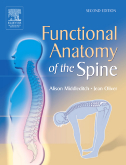|
|
|
| |
 |
|
|

|
 推薦指數:
推薦指數:





|
|
- 內容介紹
|
Functional Anatomy of the Spine, 2nd Edition
By Alison Middleditch, MCSP and Jean Oliver, MCSP, SRP
328 pages 171 ills
Trim size 7 7/16 X 9 11/16 in
Copyright 2006
Description
This book provides the solid foundation of knowledge therapists need to safely and accurately treat musculoskeletal disorders of the spine. It presents a comprehensive view of applied functional anatomy and biomechanics of the whole spine, examining normal and abnormal function of the spine, the response of tissues to injury, and the effects of age-related changes. Thoroughly referenced and extensively illustrated with over 200 original, high-quality diagrams, it serves as an excellent resource for clinical decision making. The 2nd edition explores several areas in greater depth – including the sacroiliac joint, thoracic biomechanics, muscles – and reviews recent papers and the scientific evidence of functional anatomy.
Reviews
"The authors of this book are practising, clinically experienced therapists who have packed a remarkable amount of well researched information into the modest compass of a paperback. As a vade mecum for the modern physio therapist, this is a book with a future."Physiotherapy, October 1993
Key Features
Accessory and physiological spinal movements are thoroughly described.
Palpation is covered in detail.
Numerous guidelines for safe practice are provided.
A valuable, comprehensive chapter covers posture, lifting, and the prevention of injury.
Coverage of applied anatomy and biomechanics is written by therapists for therapists.
New theories on thoracic biomechanics are presented, rarely covered by other anatomy books.
All topics have been updated to reflect recent scientific evidence, enabling the reader to more effectively formulate and manage treatment plans.
New illustrations to complement the text and improve readers' understanding of the material.
New to this Edition
A one-of-a-kind chapter covering the sacroiliac joint has been comprehensively revised.
Expanded material is provided on the autonomic nervous system, thoracic spine biomechanics, and the biomechanics of the lower limb as it relates to the spine.
New sections address adverse neural tension, cervical discs, proprioception and muscle imbalance, and mechanics of the jaw and upper cervical spine.
An update on vertebral artery and blood supply presents the latest knowledge on the subject.
|
|
|

